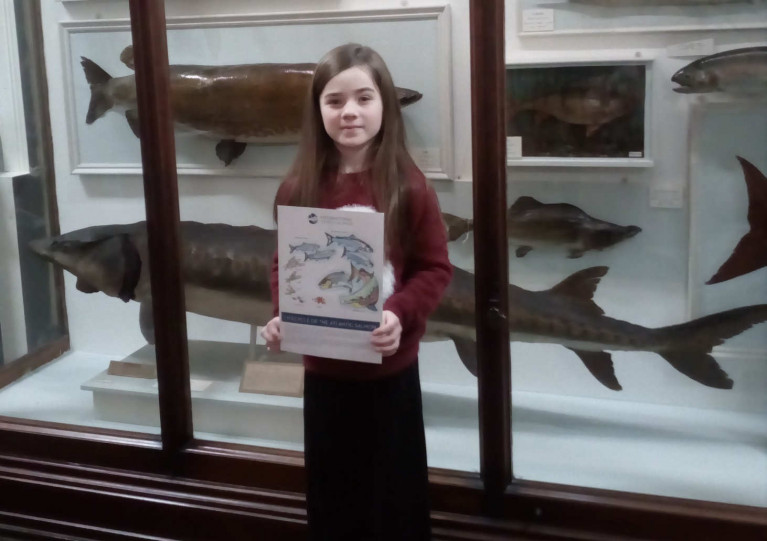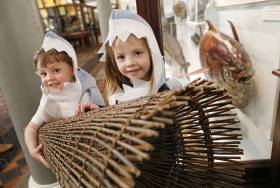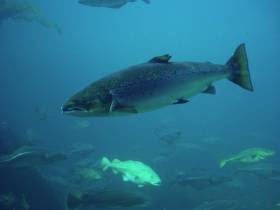Displaying items by tag: International Year of the Salmon
Young Winners Announced In National ‘Salmon Of Colour’ Competition
Two young artists have been chosen as winners of the Salmon of Colour colouring competition organised by Inland Fisheries Ireland (IFI) and the National Museum of Ireland’s Natural History branch to mark International Year of the Salmon.
Eight-year-old Maisy from Lusk, Co Dublin was selected as the winner of the 8-11 category while Molly (12) from Clonsilla in west Dublin scooped the top prize in the older 12-14 category.
They emerged from more than 1,000 entrants in the competition, which ran throughout the summer months of 2019 and which asked young artists to colour in the designated image of the lifecycle of an Atlantic salmon.
The winners will now receive a €100 voucher for the National Museum of Ireland - Natural History shop and a private, guided tour of the museum.
 Molly, aged 12 from Clonsilla, west Dublin, was chosen in the ages 12-14 category
Molly, aged 12 from Clonsilla, west Dublin, was chosen in the ages 12-14 category
The competition was delivered as part of awareness raising activities for International Year of the Salmon, which aimed to engage the public around the challenges facing salmon today.
Suzanne Campion, head of business development at IFI, said: “We are delighted that so many children took part and have engaged with us on the issues affecting salmon populations today by colouring in the salmon lifecycle and learning more about the importance of this fish and the precious nature of its existence across the Northern Hemisphere.”
In addition to the Salmon of Colour Colouring Competition, the museum and IFI partnered on a one-day Fishy Fun event in July which engaged the general public around the fisheries and angling resource and the importance of its conservation through a range of interactive activities for International Year of the Salmon.
82 Rivers To Open For Salmon Angling This Wednesday
A total of 82 rivers will open for salmon and sea trout angling in the 2020 season that commences this Wednesday 1 January.
“This will allow everyone to share in this important natural resource, for which conservation will be to the fore,” said Sean Canney, Minster of State with responsibility for inland fisheries, who added that “41 of the rivers will be fully open with a further 41 available on a ‘catch and release’ basis”.
Legislation governing the coming year’s wild salmon and sea trout fisheries was informed by management advice from Inland Fisheries Ireland (IFI) on more than 140 distinct salmon stocks, and related scientific assessments carried out by the independent Technical Expert Group on Salmon (TEGOS).
The same advice was also made available as part of a statutory public consultation process during which 27 written submissions from stakeholders were received.
Along with the 82 openings, it was recommended that 65 rivers be closed for 2020 as they have no surplus of fish available for harvest.
Minister Canney said: “Ireland is internationally recognised for elevating the conservation imperative to the pinnacle of our salmon management principles and, as the International Year of the Salmon draws to a close, I am proud to have led Ireland’s participation to this global initiative.
“Environmental change and human impacts continue to place salmon and other species at risk. I am determined that the innovations of International Year of the Salmon which brought people together to share knowledge and raise awareness will endure. This is key to ensuring the resilience of salmon in Ireland and in the entire Northern Hemisphere.”
Research Vital As International Year Of The Salmon Highlights Challenges To Iconic Species, Says Canney
Sean Canney, Minister of State with responsibility for the inland fisheries resource, visited the River Erriff in Co Mayo recently to understand more about the current issues facing Ireland’s salmon.
Inland Fisheries Ireland (IFI) has designated the River Erriff, one of Ireland's premier salmon and sea trout fisheries, as the National Salmonid Index Catchment.
Salmon and sea trout migrating upstream in the Erriff must pass through fish counting and trapping facilities located at Aasleagh Falls, where the Erriff flows into Killary Harbour.
Since 1985, salmon and sea trout smolts and kelts migrating downstream pass through a trap located below Tawnyard Lough.
The facilities at this research station are used for a wide range of scientific research and monitoring activities on the salmonid populations and their migratory behaviour.
Minister Canney met with Dr Ciaran Byrne, CEO of Inland Fisheries Ireland, who outlined that fisheries managers and scientists have been concerned for a number of years about the declining numbers of salmon returning to the Irish coast — a key concern in this International Year of the Salmon.
In the mid-1970s, almost 1.7 million salmon were estimated to have returned to Ireland, compared to only some 250,000 today.
Salmon are a key indicator species and they tell us so much about the health of our aquatic environment, IFI says.
And the issue is not unique to Ireland, as populations over the entire southern part of the North East Atlantic — which includes France, Spain, England, Scotland and southern Iceland — have declined significantly in the past number of decades.
Following the visit, Minister Canney commented: “Salmon are an iconic fish species in Ireland. They have always had a special place in Irish culture, heritage and mythology with stories such as the ‘Salmon of Knowledge’ familiar to generations of our school children.
“While they are widely distributed throughout Irish river systems, with over 140 designated salmon rivers, the numbers of salmon returning to Irish rivers, in common with salmon rivers internationally, have shown a worrying decline in recent decades.
“Today they remain an important resource to many people, playing an invaluable ecological, social and cultural role in Ireland and across the Northern Hemisphere.
“International Year of the Salmon offers us an opportunity to start an important conversation around how we can protect, conserve and restore salmon populations in Irish and international waters and how we can inspire action.
“I am delighted to see the excellent research facility here in the Erriff. I am assured that the ongoing scientific research by IFI adds to our understanding of the issues facing salmon and will inform Ireland’s position as part of the EU delegation in discussions which will shortly take place at Nasco — the North Atlantic Salmon Conservation Organisation — on this important topic.”
Fishy Fun At The Natural History Museum This July
Ireland’s fisheries resource is set to come alive at the Natural History Museum this summer at a free event called Fishy Fun.
A range of interactive activities suitable for all the family will be part of the special one-day event on Saturday 20 July, one of a number of initiatives this summer to recognise International Year of the Salmon.
Visitors to the ‘Dead Zoo’ on the day will learn about the fantastic collection of fish on display and how the salmon, Ireland’s most iconic fish species, is facing its biggest challenge yet.
Fisheries staff will be on hand to help youngsters examine the creepy crawlies which live in Ireland’s rivers and lakes via microscopes. while novice anglers can try their hand at fishing through a virtual fishing simulator.
As well as the museum collection, aquariums will also showcase some of the freshwater fish which live in waters across Ireland.
“We are looking forward to introducing the public to the mystical aquatic world at this family-focused event,” said Inland Fisheries Ireland chief Dr Ciaran Byrne.
“Novice anglers, future fisheries biologists or scientists or anyone who has an interest in the natural world will enjoy learning more about the fish and creatures which live in our waters and what we can do to ensure their ongoing conservation for future generations.”
The free Fishy Fun event will take place from 10am-4pm on Saturday 20 July in the National Museum of Ireland – Natural History, Merrion Street, Dublin 2.
As part of the event, children and schools are also invited to enter a national colouring competition, The Salmon of Colour, which will be available in the museum and online in the summer months with more information coming soon.
To track Atlantic salmon movements from river to sea and back, millions of salmon have been tagged over the past 50 years as part of scientific international tagging programmes.
Recently, ICES published a co-operative research report documenting 50 years of marine tag recoveries from Atlantic salmon, and marking 2019’s declaration as International Year the Salmon.
Programmes have included tagging of smolts, migrating out from their freshwater nurseries to the sea and their recaptures in high-seas fisheries off Norway and the Faroes, in coastal fisheries around Greenland and upon return to home waters.
Other studies included tagging of adults caught at sea and their subsequent recaptures in home waters in coastal fisheries and by anglers.
“Tagging and related data efforts are crucial as scientists seek to improve understanding of wild Atlantic salmon distribution and migration at sea and the underlying causes of mortality,” said Niall O'Maoileidigh of the Marine Institute.
“This is particularly important given that, despite initiatives that have mitigated some declines, abundance of the species has continued to drop in the last two decades.”
Tagging has included various types of external ‘floy tags’ focusing in the past 20 years on coded wire tags, less than 2mm in length and delicately implanted into the nose cartilage of fish.
This report not only documents the history of these tagging programmes for posterity but also investigates migration patterns, timings, return rates, their changes and patterns.
“Mass marking techniques still provide basic information on survival rates, exploitation rates and migration in general. However, with current technology e-tagging is becoming far more informative, giving rise to information not only of the ‘when and where’ of tagging-releases and recaptures, but also on the movements, routes, depths and behaviours in-between,” O’Maoileidigh added.
Earlier this week Ireland’s first salmon of 2019 was caught and released on New Year’s Day in Co Donegal.
#Angling - Only hours after 84 Irish rivers were opened to salmon angling on Tuesday 1 January, the first salmon of 2019 was caught and released on the Lackagh River in Co Donegal.
Michael McCann of Templeard, Derry landed the 5lb fish in the Garden Pool on the Lackagh River at 9.25am yesterday using a single barbless hook, before it was released back into the water.
The fish was also the first salmon caught and released during International Year of the Salmon which takes place throughout 2019.
McCann was one of 22 anglers who were fishing on the Lackagh at the time of the catch. The river is not known for producing the first salmon of the angling season — in 2018, the first was recorded on the River Drowes in Leitrim on 30 January while in 2017 it was caught on the Munster Blackwater in Cork on 1 February.
Congratulating McCann on his catch, Dr Ciaran Byrne, CEO of Inland Fisheries Ireland, said: “We are particularly delighted that the first salmon of 2019 was caught and released in a sustainable manner in Donegal in compliance with the 2019 regulations.
“I would urge anglers to step up their conservation efforts and engage in catch and release angling in 2019. The new year coincides with International Year of the Salmon which aims to raise awareness of some of the challenges facing salmon stocks across the Northern hemisphere.
“Salmon populations have plummeted in recent years with the number of salmon returning to Irish shores decreasing by over 70%, which is very concerning.
“We look forward to promoting this global initiative in Ireland which aims to bring people together to share knowledge, raise awareness and take action on how we can ensure the resilience of salmon in Ireland and across the Northern hemisphere.”
The Lackagh River is open to catch and release fishing during the 2019 season. The regulations for the management of the wild salmon and sea trout fishery for 2019 including the list of open, catch and release and closed rivers can be found on the IFI website.



































































